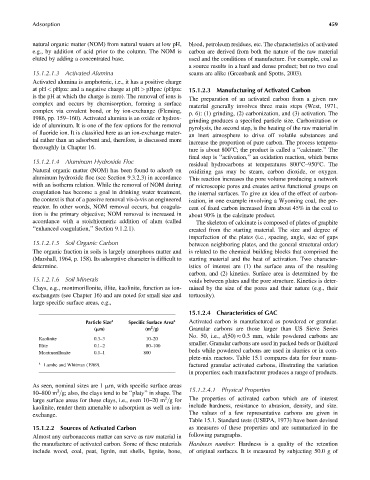Page 504 - Fundamentals of Water Treatment Unit Processes : Physical, Chemical, and Biological
P. 504
Adsorption 459
natural organic matter (NOM) from natural waters at low pH, blood, petroleum residues, etc. The characteristics of activated
e.g., by addition of acid prior to the column. The NOM is carbon are derived from both the nature of the raw material
eluted by adding a concentrated base. used and the conditions of manufacture. For example, coal as
a source results in a hard and dense product; but no two coal
15.1.2.1.3 Activated Alumina seams are alike (Greenbank and Spotts, 2003).
Activated alumina is amphoteric, i.e., it has a positive charge
at pH < pHpzc and a negative charge at pH > pHpzc (pHpzc 15.1.2.3 Manufacturing of Activated Carbon
is the pH at which the charge is zero). The removal of ions is
The preparation of an activated carbon from a given raw
complex and occurs by chemisorption, forming a surface
material generally involves three main steps (West, 1971,
complex via covalent bond, or by ion-exchange (Fleming,
p. 6): (1) grinding, (2) carbonization, and (3) activation. The
1986, pp. 159–160). Activated alumina is an oxide or hydrox-
grinding produces a specified particle size. Carbonization or
ide of aluminum. It is one of the few options for the removal
pyrolysis, the second step, is the heating of the raw material in
of fluoride ion. It is classified here as an ion-exchange mater-
an inert atmosphere to drive off volatile substances and
ial rather than an adsorbent and, therefore, is discussed more
increase the proportion of pure carbon. The process tempera-
thoroughly in Chapter 16.
ture is about 8008C; the product is called a ‘‘calcinate.’’ The
final step is ‘‘activation,’’ an oxidation reaction, which burns
15.1.2.1.4 Aluminum Hydroxide Floc
residual hydrocarbons at temperatures 8008C–9508C. The
Natural organic matter (NOM) has been found to adsorb on oxidizing gas may be steam, carbon dioxide, or oxygen.
aluminum hydroxide floc (see Section 9.3.2.3) in accordance This reaction increases the pore volume producing a network
with an isotherm relation. While the removal of NOM during of microscopic pores and creates active functional groups on
coagulation has become a goal in drinking water treatment, the internal surfaces. To give an idea of the effect of carbon-
the context is that of a passive removal vis-à-vis an engineered ization, in one example involving a Wyoming coal, the per-
reactor. In other words, NOM removal occurs, but coagula- cent of fixed carbon increased from about 45% in the coal to
tion is the primary objective; NOM removal is increased in about 90% in the calcinate product.
accordance with a stoichiometric addition of alum (called The skeleton of calcinate is composed of plates of graphite
‘‘enhanced coagulation,’’ Section 9.1.2.1). created from the starting material. The size and degree of
imperfection of the plates (i.e., spacing, angle, size of gaps
15.1.2.1.5 Soil Organic Carbon between neighboring plates, and the general structural order)
The organic fraction in soils is largely amorphous matter and is related to the chemical building blocks that comprised the
(Marshall, 1964, p. 158). Its adsorptive character is difficult to starting material and the heat of activation. Two character-
determine. istics of interest are (1) the surface area of the resulting
carbon, and (2) kinetics. Surface area is determined by the
15.1.2.1.6 Soil Minerals voids between plates and the pore structure. Kinetics is deter-
Clays, e.g., montmorillonite, illite, kaolinite, function as ion- mined by the size of the pores and their nature (e.g., their
exchangers (see Chapter 16) and are noted for small size and tortuosity).
large specific surface areas, e.g.,
15.1.2.4 Characteristics of GAC
Particle Size a Specific Surface Area a Activated carbon is manufactured as powdered or granular.
2
(mm) (m =g) Granular carbons are those larger than US Sieve Series
No. 50, i.e., d(50) 0.3 mm, while powdered carbons are
Kaolinite 0.3–3 10–20
smaller. Granular carbons are used in packed beds or fluidized
Illite 0.1–2 80–100
beds while powdered carbons are used in slurries or in com-
Montmorillonite 0.1–1 800
plete-mix reactors. Table 15.1 compares data for four manu-
a
Lambe and Whitman (1969). factured granular activated carbons, illustrating the variation
in properties; each manufacturer produces a range of products.
As seen, nominal sizes are 1 mm, with specific surface areas 15.1.2.4.1 Physical Properties
2
10–800 m =g; also, the clays tend to be ‘‘platy’’ in shape. The
2
large surface areas for these clays, i.e., even 10–20 m =g for The properties of activated carbon which are of interest
kaolinite, render them amenable to adsorption as well as ion- include hardness, resistance to abrasion, density, and size.
exchange. The values of a few representative carbons are given in
Table 15.1. Standard tests (USEPA, 1973) have been devised
15.1.2.2 Sources of Activated Carbon as measures of these properties and are summarized in the
Almost any carbonaceous matter can serve as raw material in following paragraphs.
the manufacture of activated carbon. Some of these materials Hardness number: Hardness is a quality of the retention
include wood, coal, peat, lignin, nut shells, lignite, bone, of original surfaces. It is measured by subjecting 50.0 g of

